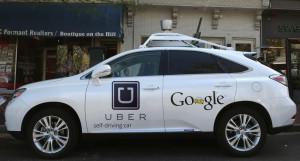Today’s San Francisco Chronicle includes this article about friction between Uber and the company’s drivers. This got me thinking about the possibility that Uber will have to disrupt itself in order to stay competitive, possibly not too long from now.
Uber and competitors such as Lyft and Sidecar are taking market share from traditional taxi services by providing a product that outperforms traditional taxis in three key value dimensions: convenience, reliability, and predictability (and, you could argue, coolness). When I need a ride, I can get out my phone, open the Uber app, and immediately know where the cars are that can pick me up and how long it will take for one to get here. It sure beats waiting on the curb and praying for good luck, or calling yellow cab and hoping the dispatcher understood me.

In order to make the service work, Uber needs drivers, and the Chronicle article illustrates that getting a network of high quality drivers will require skillful execution. For Uber to thrive, one of the things the company is going to need to get good at is creating and maintaining this network of drivers. It is essential to their success.
But will it eventually become irrelevant? In our chapter The Five Moves in the Innovator’s Playbook we describe how Netflix had to disrupt itself in order to transition from a business powered by postal mail DVD distribution to one based on streaming media. One of their core competencies, an amazingly fast, super automated method of getting DVDs by mail to just about anywhere in 2 days (or less!), had become irrelevant. It was a cornerstone of their success, until suddenly it wasn’t.
Is Uber looking at a similar self-disruption, when it transitions from it’s driver network to self-driving vehicles? How far away is that day? And when it does get here, how much will we tip our robot drivers?
– Matt Brocchini

The plot thickens! Check out this article:
http://www.nytimes.com/2014/05/28/technology/googles-next-phase-in-driverless-cars-no-brakes-or-steering-wheel.html
This quote in particular caught my eye:
“The researchers found that Manhattan’s 13,000 taxis made 470,000 trips a day. Their average speed was 10 to 11 m.p.h., carrying an average of 1.4 passengers per trip with an average wait time of five minutes.
In comparison, the report said, it is possible for a futuristic robot fleet of 9,000 shared automated vehicles hailed by smartphone to match that capacity with a wait time of less than one minute. Assuming a 15 percent profit, the current cost of taxi service would be about $4 per trip mile, while in contrast, it was estimated, a Manhattan-based driverless vehicle fleet would cost about 50 cents per mile.”
If a driverless Uber was 5 times more convenient than a taxi (based on wait time) and 1/8 the cost, that would obviously create much higher product market fit and a huge competitive advantage over human-driven taxis. And not just taxis – why own a car if you can get one when you need it that easily?